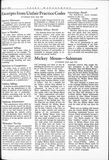


Walter Disney's beloved character has gone to work as a salesman for more than thirty manufacturers. And now Mickey Mouse is creating new advertising ac- counts and opening up new sales channels for everything from ice cream and wrist watches to pajamas.
FIVE years ago Walter Disney, a young cartoonist of Kansas City, was curtly dismissed from every motion picture studio in Hollywood as just another nut with a freak idea. He had a cartoon character he called "Mickey Mouse" and he thought there might be an opportunity to use it in a series of animated movie shorts.
Disney finally persuaded a small, independent producer to turn out jüst one single picture. It made a little money. They produced another. And it wasn't many more months until Hollywood's unbelieving ears were hearing tales - true tales - of moviegoers who phoned local theaters to ask not about the feature picture, but to inquire if Mickey Mouse was "on." Since that time Mickey Mouse has become a world character, as widely known as Mahatma Gandhi, Henry Ford, or Charlie Chaplin. Per minute of showing, theaters pay more for Mickey Mouse than for Greta Garbo.
All of which is by way of a prelude to this story which is really about merchandise and not about movies.
Between two and three years ago Walter Disney began to license manufacturers to use "Mickey Mouse" as a brand name, with the well-known figure of Mickey himself as a trade character. So steadily did this business mount up that a special company in charge of Kay Kamen was formed to take care of it. Today some thirty-odd manufacturers are using Mickey Mouse, all of them in different or at least non-competitive fields.
Manufacturers are licensed on a royalty basis, usually for a year's period, with an option of renewal. In some cases the channels of distribution are specified, as, for example, Seneca Textile Mills, who are licensed to make drapery materials by the yard for sale through retail stores only. They cannot sell to other manufacturers for fabrication.
In every case only reputable manufacturers are selected for licensing, and the character of the goods turned out under the trade-mark is rigidly checked. In some instances definite standards are set.
[...]